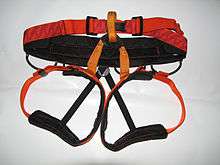Climbing harness

A climbing harness is an item of climbing equipment for rock-climbing, abseiling, or other activities requiring the use of ropes to provide access or safety such as industrial rope access, working at heights, etc. A harness secures a person to a rope or an anchor point.[1]
In its simplest form, a harness can be made from a length of rope or a nylon webbing tied round the waist. More sophisticated harnesses exist in many patterns, designed to give greater comfort and security, and more options for carrying equipment.
While harnesses can be improvised, it is more common to use commercially produced harnesses, which often include padding and amenities such as gear loops. Most commercial climbing harnesses meet the guidelines and manufacturing standards of organizations such as the Union Internationale des Associations d'Alpinisme or European Committee for Standardization. More expensive harnesses are not necessarily better, as different types of harnesses are better suited to different body types and activities, regardless of price range.
History
The invention of the climbing harness has been attributed to Jeanne Immink, a Dutch climber in the late nineteenth century.[2] Some of the first climbing harnesses were devised in the U.K. in the early 1960s by Alan Waterhouse, Paul Seddon and Tony Howard who went on to form the Troll climbing equipment manufacturers.[3] A harness designed by British climber Don Whillans was made by Troll for the 1970 Annapurna South Face Expedition. It went into mass production shortly afterwards and soon became popular worldwide.[4]
Types

A sit harness consists of a waist belt and two leg loops which are normally connected in the front of the hips through a permanent webbing loop called a belay loop. These are the most commonly used harnesses for recreational activities such as abseiling and rock climbing, as they afford a wide range of movement while still maintaining a high level of safety. Ensuring the harness fits correctly is key to avoiding pain in the upper thigh area caused by the leg loops being too tight around the upper legs and groin area, while at the same time ensuring that a climber flipped over in a fall does not slip out.
A chest harness is worn around the shoulders, usually with a sit harness so as to provide an additional attachment point. This attachment point allows for better balance in some situations such as when carrying a heavy pack (as the centre of mass is below the connection to the rope) and when the person in the harness may be unable to maintain an upright position (due to injury or other influences).
A full-body harness is the combination of a sit harness and a chest harness which are permanently or semi-permanently connected to each other. This kind of harness normally offers a wide range of attachment points. It is most commonly used in industrial/rescue situations, and also commonly used by small children instead of a sit harness.
Materials
Most of the harnesses is generally made from webbing. This webbing is often nylon webbing as polyester webbing doesn't hold triglides and d-rings as well, and it's easier to untie nylon webbing.[5][6][7] The webbing is often also tubular webbing, instead of flat webbing.[8]
See also
References
- ↑ Cox, Steven M.; Kris Fulsaas, eds. (2003-09). Mountaineering: The Freedom of the Hills (7 ed.). Seattle: The Mountaineers. ISBN 0-89886-828-9. Check date values in:
|date=(help) - ↑ Harry Muré (2008). "Jeanne Immink". FemBio.org. Retrieved 19 April 2014.
- ↑ http://ktml.freeservers.com/Misc/Troll.pdf
- ↑ http://emj.bmj.com/letters/?first-index=207&hits=25
- ↑ Nylon webbing popular choice for climbing gear
- ↑ Nylon vs polyester webbing
- ↑ Breaking strength of nylon and polyester being about the same
- ↑ Tubular vs flat webbing
External links
How to choose a climbing harness?
| Wikimedia Commons has media related to Climbing harnesses. |